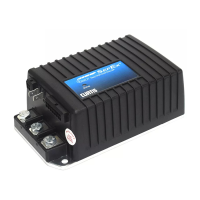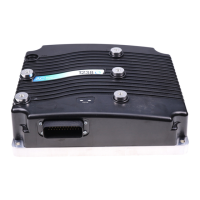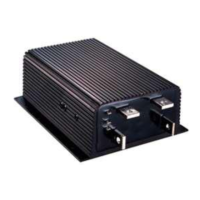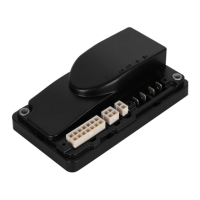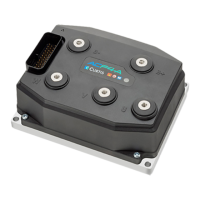30
Curtis 1230 Manual, Rev. C
3 — PROGRAMMABLE PARAMETERS: Sequencing Parameters
SEQUENCING MENU
ALLOWABLE
PARAMETER RANGE DESCRIPTION
Interlock Normally Open OFF/ON When a normally-open type of interlock switch is used, this parameter
must be programmed On.
Sequencing Delay 0.0–3.0 sec. The sequencing delay feature allows the interlock switch to be cycled
within a set time (the sequencing delay), thus preventing inadvertent
activation of HPD and SRO. This feature is especially useful in applica
-
tions where the interlock switch may bounce or be momentarily cycled
during operation. When set to 0.0, there is no delay.
Static Return To Off (SRO) 0–3 The SRO feature prevents the vehicle from being started when “in gear.”
SRO checks the sequencing of the interlock input—or the interlock input
and KSI—relative to a direction input. If a direction is selected before or
simultaneously (within 50 msec) with the interlock input, controller output
is inhibited. SRO faults can result from using an incorrect sequence, or
from using a correct sequence with less than 50 msec between steps.
Three types of SRO are available, along with a “no SRO” option:
0 = no SRO
1 = SRO unless interlock input before a direction input
2 = SRO unless KSI before interlock input before a direction input
3 = SRO unless KSI before interlock input before a forward direction
input
If you select SRO Type 2, the following sequence must be followed to
enable the controller:
STEP 1, turn on KSI; STEP 2, activate interlock; then
STEP 3, select a direction. The interval between steps 1 and 2 is the same
as between steps 2 and 3; that is, KSI input must precede interlock input
by at least 50 msec. Once the controller is operational, turning off either
KSI or the interlock causes the controller to inhibit its output; re-enabling
the controller requires the 3-step sequence.
Similarly, if your controller is programmed so that KSI, interlock, and
forward inputs are all required (SRO Type 3), they must be provided in that
sequence in order to enable the controller. Note, however, that operation
is allowed if a reverse input precedes the interlock input; this can be useful
when operating a walkie on ramps.
Sequencing delay (above) can be used to provide a brief delay before
SRO inhibits controller output, if desired.
High Pedal Disable (HPD) 0–2 HPD prevents the vehicle from being started if the controller is turned on
with the throttle applied. In addition to providing routine smooth starts,
HPD also protects against accidental sudden starts if problems in the
throttle linkage (e.g., bent parts, broken return spring) give a throttle input
signal to the controller even with the throttle released.
If the operator attempts to start the vehicle with the throttle already
applied, the controller will inhibit output to the motor until the throttle input
is reduced to zero. For the vehicle to run, the controller must receive a KSI
input—or KSI and interlock inputs—before receiving a throttle input greater
than zero.
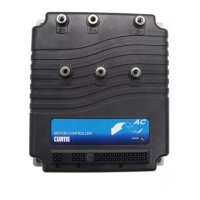
